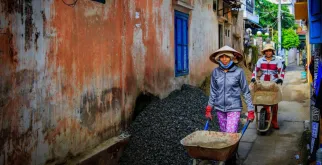Today, we celebrate International Volunteer Day to recognize the importance of efforts made by volunteers throughout the world to help those who are not able to help themselves, those excluded and left behind.
Events are being organized around the world to promote volunteering, to award the most dedicated volunteers and to inspire people to act for a better future.
Yet, many volunteers will not take part in the celebrations, as what they do is not seen as volunteering, not even by themselves. These are men and women of all ages who willingly provide unpaid help to others, without being organised by NGOs, associations or other institutions. They are the good neighbours, friends and even strangers ready to give a helping hand; they are often the first to respond in a time of crisis. In its statistical framework, the ILO defines them as direct volunteers. You are probably one of them.
Analysis by the UN Volunteers (UNV) programme shows that worldwide, direct volunteers perform about 70% of volunteer work. Still, in many countries their work is not seen as contributing to society, even though their efforts help individuals avoid exclusion and make communities stronger. ILO and UNV recently joined forces to support countries in changing this perception by increasing the visibility of direct volunteers in official statistics. Making these important activities visible is critical to ensure that volunteer groups have a voice when it comes to the design and implementation of development policies as called for in the 2030 Agenda for Sustainable Development.
The first step toward this objective was completed in 2011, when the ILO Manual on the measurement of volunteer work was published. In 2013, labour statisticians took another important step by defining volunteer work in the international statistical standards at the 19th ICLS.
As part of a joint project initiated in 2017, ILO and UNV are taking the next step: developing measurement tools to assist countries with quantifying direct volunteer work. Currently, these tools are being tested in Ukraine and Senegal. The initial results indicate that people do volunteer work a lot more often than they think. Governments are also realising that direct volunteering is an important resource and want to make it visible through the data they produce.
This shift in perspective is especially necessary in developing countries, where low access to paid and public services makes people rely on mutual aid as an important livelihood strategy. Without comprehensive statistics on the volunteer work taking place within communities, it is impossible to value its contribution to poverty alleviation and wellbeing and to develop policies that support, promote and tap into this resource.
ILO and UNV will release the new measurement tools and guidance on their application in labour force surveys in the first half of 2020. Meanwhile, to support countries that want to measure volunteer work in the 2020 round of population and housing censuses, we released guidance adapted for these censuses.
The 2030 Agenda calls on each of us to change the world, as “we may be the last generation to have a chance of saving the planet and future of humanity”. A key contribution of statisticians is to make the invisible visible through more and better data. This clearly applies to the important work done by volunteers throughout the world.
Vladimir Ganta is a statistician in the Labour Force Survey Team, Department of Statistics of the International Labour Organization (ILO). He specializes in the measurement of volunteer work. His blog was first published on the website of the ILO Department of Statistics.

